“What is Resistance to Sulfuric Acid and Hydrochloric Acid Dew Point Corrosion? ~An Explanation!! vol.1~”
- Product
- S-TEN

“The content of this article reflects our company’s views and does not guarantee all aspects. When purchasing or processing products, please ensure to consult with professionals, including our company, and verify the materials in accordance with the intended purpose and use.”
This time, I would like to write about corrosion-resistant steel.
This is about sulfuric acid dew point corrosion-resistant steel, which is a niche and special material among corrosion-resistant steels.
Among sulfuric acid dew point corrosion-resistant steels, the explanation will focus on S-TEN®, an original standard by Nippon Steel. S-TEN ®was trademarked in the 1970s.
What is S-TEN®?
There are S-TEN1 and S-TEN2.
Around the end of the 20th century, when air pollution caused by dioxins from waste incineration became a problem, the rapid cooling of incineration gases resulting in low temperatures began to cause issues with hydrochloric acid dew point corrosion of steel materials.
S-TEN1 ®was originally said to be relatively resistant to hydrochloric acid dew point corrosion. However, Nippon Steel quickly took the initiative to improve this and modified S-TEN1 ®to make it even more resistant to hydrochloric acid dew point corrosion. At the time, it was referred to as ‘New S-TEN1,’ but the current S-TEN1 ®is this improved version.
For this reason, the S-TEN® catalog has been updated to ‘Sulfuric Acid and Hydrochloric Acid Dew Point Corrosion-Resistant Steel.’ However, as will be mentioned later, the only product recommended as hydrochloric acid dew point corrosion-resistant steel is S-TEN1®.
What are sulfuric acid dew point corrosion and hydrochloric acid dew point corrosion?
So, what exactly are sulfuric acid dew point corrosion and hydrochloric acid dew point corrosion? What we commonly experience in our daily lives is the water dew point.
Water vapor in the indoor air reaches 100% humidity near glass cooled by the cold outside air, leading to condensation. The temperature at which the humidity reaches 100% is called the dew point temperature. By the way, steam is formed when water vapor is cooled in the air and turns into fine liquid particles, which can be considered a form of temporary condensation in the air.
Car windows can fog up on the inside or the outside, depending on the temperature and humidity inside and outside the car. However, what occurs is simply condensed water.
sulfuric acid dew point
Next is the sulfuric acid dew point.
Crude oil and similar fuels contain sulfur (S) as an impurity. When these fuels are burned, the sulfur is oxidized and released as SOx. Most of it becomes SO2, but a portion undergoes further oxidation and turns into SO3.
Additionally, combustion gases contain water vapor (H2O), and when SO3 combines with H2O, it forms H2SO4 (sulfuric acid). In terms of a chemical reaction, it is simply expressed as SO3 + H2O → H2SO4. The condensation of this sulfuric acid vapor is referred to as the ‘sulfuric acid dew point.
At the sulfuric acid dew point, high-temperature and high-concentration sulfuric acid forms, which causes corrosion. To make matters worse, the dew point temperature, which would typically be around 50°C with only water vapor in the exhaust gas, jumps to approximately 130°C with just 0.001% sulfuric acid vapor present.
Under many conditions, the dew point temperature exceeds 100°C. A high dew point temperature means that condensation will occur if there are surrounding materials with a lower temperature. Since it is difficult to maintain ducts, chimneys, and other piping at such high temperatures, condensation tends to occur easily.
The concentration of sulfuric acid is determined by the temperature at that time (based on the gas-liquid equilibrium state).
The conditions shown in Figure 1 of the Nippon Steel catalog, such as 60°C–40%, 80°C–60%, and 120°C–75%, correspond to this. Steel materials that suppress corrosion under the temperature and concentration of sulfuric acid generated at these dew points are referred to as sulfuric acid dew point corrosion-resistant steels.
Corrosion does occur, but the absolute amount can be suppressed. In particular, under severe conditions such as 60°C–40%, 70°C–50%, and 140°C–80%, it shows significant improvement compared to stainless steel across a wide range of conditions. In this field, it outperforms expensive stainless steel, which is one of the reasons why S-TEN® is highly valued.
It should be noted that sulfurous acid, formed by the reaction of SO2 and H2O, can be an issue as acid rain. However, since it is not as corrosive as sulfuric acid, it will be omitted here.

1) Nippon Steel, Sulfuric Acid and Hydrochloric Acid Dew Point Corrosion-Resistant Steel: S-TEN® Technical Data, p.2.
The hydrochloric acid dew point
The hydrochloric acid dew point is similar. Hydrochloric acid (HCl) is generated, for example, when vinyl chloride products are incinerated. This is why hydrochloric acid dew point corrosion is likely to occur at waste incineration facilities.
One major difference from sulfuric acid dew point corrosion is that the dew point temperature does not rise as high as with sulfuric acid. While the sulfuric acid dew point increased by tens of degrees Celsius compared to the water dew point, the temperature difference for the hydrochloric acid dew point is around 10°C or may even remain unchanged. Therefore, it does not reach the high temperature and high concentration of the sulfuric acid dew point, but rather stays at a level of about 60°C–20%.
“S-TEN1 ®was developed as an improvement for such conditions.”
It is important to note that when the temperature drops further and falls below the water dew point, in addition to the condensation of hydrochloric acid due to the hydrochloric acid dew point, water condensation also occurs. As a result, the condensed hydrochloric acid is diluted with water, becoming dilute hydrochloric acid. Under such conditions, S-TEN1 ®cannot be considered the best option.
Precautions for the application of S-TEN®
There are cases where S-TEN® is mistakenly thought to be sulfuric acid-resistant steel that performs well against any type of sulfuric acid. However, it is specifically designed for the unique conditions of the sulfuric acid dew point, where it suppresses corrosion better than other steel materials, including general stainless steel. For dilute sulfuric acid, stainless steel is superior, as it experiences almost no corrosion and performs better in such conditions.
The same applies to the hydrochloric acid dew point. Stainless steel may perform better with dilute hydrochloric acid. However, the absolute amount of corrosion is not that significant, and it is likely that it does not pose as much of a problem as acid dew point corrosion.
Operational improvements
Sulfuric acid dew point corrosion and hydrochloric acid dew point corrosion can also be suppressed through operational improvements. This involves keeping the exhaust gas temperature higher than the dew point and ensuring that, even if the piping is slightly cooled by external air, it remains above the dew point temperature.
However, pursuing efficiency in power plants involves using waste heat for heat exchange, which results in a drop in temperature. Additionally, measures for dust treatment are also moving toward lower temperatures. In waste incinerators, rapid cooling of exhaust gas is implemented as a measure against dioxins.
As such, raising the exhaust gas temperature is not very practical. Even if the exhaust gas temperature were raised, it would inevitably drop during operations such as shutdowns, which means sulfuric acid dew point corrosion can still occur. Additionally, while desulfurization equipment can remove a significant amount of SOx, it cannot eliminate it completely, and sulfuric acid dew point corrosion can still occur in the processes before the desulfurization stage.
Vol.1 Summary
We have provided an explanation of the overview of S-TEN®, sulfuric acid dew point corrosion, and hydrochloric acid dew point corrosion, as well as notes on its application and operational considerations.
In the next vol.2, we will…
・Specifications of S-TEN ®
・Details about S-TEN1®and S-TEN2®
・Welding and processing of S-TEN®
・Applications/examples of use
We will provide explanations on these topics.
If you are considering corrosion-resistant steel, sulfuric acid, or hydrochloric acid dew point corrosion-resistant steel plates, please feel free to contact Kumagai, which has extensive processing experience and abundant inventory.
We are a specialized trading company based in Japan, dealing in high-tensile steel and other special steels.
Please feel free to contact us.
Feel free to email us.
↓↓↓
info@kumagai-steel.co.jp

